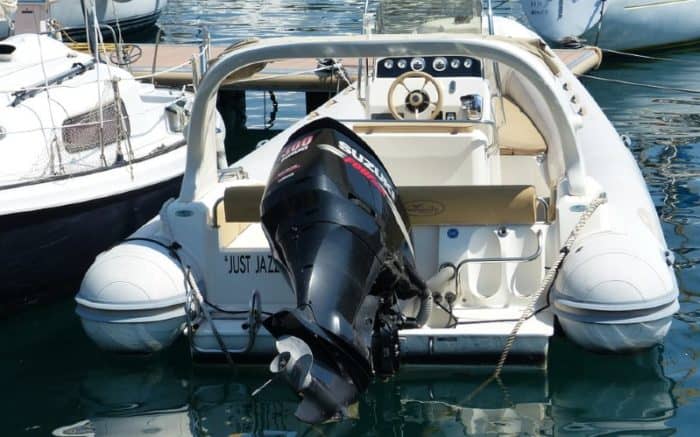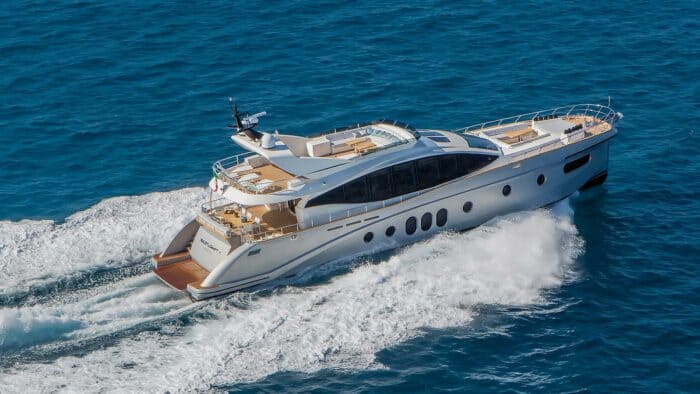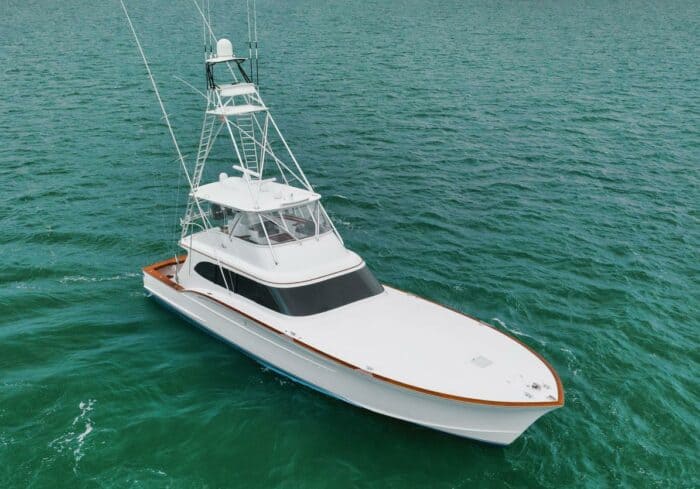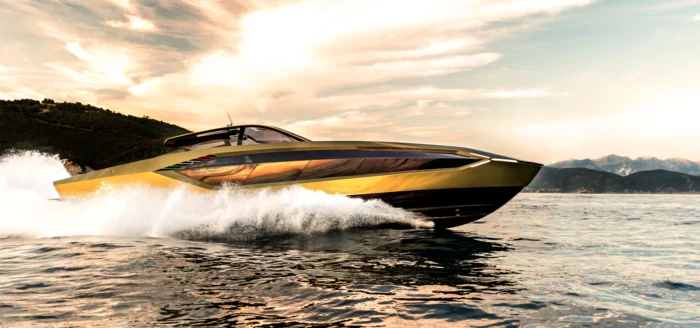Inboard vs Outboard Motors: What’s the Difference?
Inboard and outboard motors are arguably the two most popular types of motors available on boats, though they are not the only ones. Most people are familiar with one or the other (or both) and each kind has its own advantages and disadvantages as well as instances where they are more common or beneficial to you as a boater. Let’s take a look at what makes them different and how each one works.
What is an Inboard Motor?

Inboard motors are also called sterndrives on occasion and, as the name suggests, they are found inside the boat rather than on the outside like an outboard. These inboard engines are a permanent fixture in the boat’s hull and need to be accessed from inside the boat as well should they ever need to be repaired or maintained.
Inboard motors have a driveshaft kind of like a car that connects to the propeller. If it’s a sterndrive engine, then the engine itself is inside the boat but the steerable part of your motor will be mounted on the stern of the boat. Most inboard motors are actually these I/O motors.
If you have a true inboard then the engine will be centrally located in the boat and connected to the propeller. The rudders and steering are a separate mechanism and not connected to the propeller.
What are Inboard Outboard Motors or I/O Motors?
An I/O motor or inboard/outboard is just another name for that sterndrive style of inboard engine. Because it has some outboard components, it is called inboard/outboard.
What is an Outboard Motor?

An outboard motor is the most easily recognizable kind of propulsion system on a boat. The motor is mounted on the outer hull of the boat. In smaller jon boats and aluminum fishing boats the motor is controlled by hand right at the motor itself. You can start the engine and steer it by sitting right there next to it. On larger boats the outboards are controlled with a steering system that lets you drive the boat from the helm with the use of a wheel.
Outboard engines can be removed or replaced fairly easily, at least compared to inboards. Outboard motor powered crafts are typically cheaper at the smaller end of the scale and a little more versatile for most boat owners. Outboard power is pretty reliable and easier to understand and maintain for most boaters so this is a popular option when you’re looking to do more casual boating.
How Do Inboard Motors Work?

Inboard engines function a lot like car engines. You’ll likely have a four stroke that powers the drive shaft. Unlike a car engine which transfers the energy of the drive shaft to the axles and causes the tires to rotate, the shaft in your inboard causes the propeller located to the rear of the boat to rotate.
The spinning propeller gives the boat forward thrust and the steering of the boat causes a separate rudder system to move when you turn the wheel allowing you to maneuver left and right. Steering therefore is one of the most significant differences between inboards and their outboard counterparts.
How Do Outboard Engines Work?

An outboard motor may be a four stroke or a simpler two stroke engine. The crankshaft in your outboard turns the drive shaft which runs down the length of your engine from the large case that holds the engine proper down to the lower unit of the outboard where the propeller is located.
The spinning driveshaft is attached to a gear box which is in turn attached to the prop and it rotates, spinning the propeller and creating that forward propulsion. Because the entire outboard is able to be controlled it can be moved either by hand, as is the case with those smaller boats, or by the steering mechanism of larger boats. This allows the outboard to act as its own steering/rudder system so you can maneuver by altering the direction the propeller
Your lower unit will have a skeg on the bottom that is like a smaller fin or rudder and a tiller or handle on the top of the unit to allow you to steer. The skeg helps the engine maneuver and turn smoothly and the tiller allows you to move and adjust the entire unit as needed.
Main Differences Between an Inboard and an Outboard Motor
| Inboard | Outboard |
| Engine located inside the hull | Engine located on outside of hull |
| Quieter than an outboard | Often much louder than an inboard |
| Harder to reach for repairs | Easier to repair and maintain |
| Heavier engine overall | Fairly lightweight |
| Longer lasting | Shorter lifespan |
| Takes up significant space inside boat | Outside hull means more room |
| More expensive to repair | Fairly low cost to maintain |
| More fuel efficient than outboards | Less fuel efficient than inboard |
| Better resale value | Loses more value over time |
| Harder/costlier to winterize | Can be removed to store for winter |
| Essentially invisible | Always out where you can see it |
| Easier to swim/fish from rear of boat | Potential obstruction/danger |
| Less able to handle colder conditions | Not as much of a freeze risk |
The Cost of Inboard and Outboard Motors

Boats with outboards tend to be more expensive than inboards of equivalent power by a small margin. But it’s also worth keeping in mind that there are other costs such as fuel and maintenance which can affect the overall picture. Inboard maintenance is costlier.
In terms of much larger boats, such as yachts, then the price margins switch again and an inboard vessel is going to end up costing you a lot more again. This is generally because larger boats need propulsion systems that are much more unique to the vessel than just standard engines can provide and, of course, you can’t really have a vessel with four or five decks that’s running a couple of outboards. The boat power requirements are different and that needs to be accounted for.
Inboard motors are usually more expensive at the low end of the scale. A cheap inboard motor may be around $8,000 to $10,000. They will increase from there and can easily reach $25,000 to $30,000 and more.
On the other hand, outboard motor costs are some of the most impressively varied things you’ll ever see. You can get a very low powered outboard for as little as $1,000. Middle of the road outboards may cost you $15,000 to $20,000. And high performance outboards can cost you $70,000 to $100,000. Oftentimes a high powered outboard motor will be more expensive than the entire rest of the boat and everything in it.
The Seven Marine 627sv was about $100,000 before they stopped production. The Mercury V12 Mercado is around $77,000.
Inboard Motor vs Outboard Motor Performance

Head to head an outboard motor looks like it performs better thanks to the power to weight ratio. An inboard is a heavier engine so that takes some wind out of its sails, so to speak. That means a 250 horsepower inboard will probably perform on par with a 200 horsepower outboard. But it’s worth noting that an inboard is also more fuel efficient which can alter that performance metric for you as well.
Suffice it to say that both inboards and outboards can be extremely powerful and get the job done for you regardless of what you need your boat for. Outboards can get up to 600 horsepower or more and, of course, you can always install double or triple engines as well. In the past, larger boats were almost exclusively inboard but as more powerful and cost efficient outboards are made, you can find larger boats relying on these powerful motors more and more.
Fuel efficiency is actually a bit of a gray area for many engines because older engines may not be as reliable as newer more fuel efficient designs. For that reason you’ll probably also come across a lot of people who swear an outboard is more efficient. And sometimes that’s probably true, but not always and not in a lot of tests.
The Bottom Line
The major difference between an inboard and an outboard motor is where they are located on the boat. The inboard is inside the hull of the boat while the outboard is attached to the outside of the hull. Each engine has its own pros and cons in terms of performance and costs that can affect which will be more useful to you as a boater and, as such, neither is really better than the other. They’re different and perform differently depending on what you need.
Categories: Boats












1 Comment
Jack Ducan on March 21, 2023
I prefer the inboard engines because the horsepower of inboard engines is higher than outboard motors, it also requires less maintenance despite being more pricey upfront. They only take up a little room inside your boat too and it’s really ideal for smaller boats.